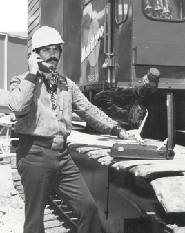|
||||||||||||||||||||||||||||||||
 |  |
|  |
Message from the Director
![]() Since
1973 I have worked in radio, telecommunications and
Since
1973 I have worked in radio, telecommunications and
Surprisingly, there are still many voids and limits that need to be addressed for customers who fall outside the normal curve of typical users. Wireless communications have their limits and there are many opportunities for optimizing performance and reducing electromagnetic (EM) leakage and radio frequency (RF) field interference.
One issue that has endured for over seven years and will likely continue for another several years is the Hearing Aid Compatibility (HAC) issue. The pulse nature of digital cellular phones proximate to a user's hearing aid cause the digital pulses to be demodulated in the form of buzzing sounds. Many hearing aid manufacturers have installed RF immune components in the more expensive aids, but currently over 70% of the aids in use or sold today are not immune and will likely remain so for several years. In addition, hearing aids with Telecoil pick-ups have problems with all handsets.
With mandates by Congress and the FCC to correct the problem, Vortis Technology took a leadership role by filing petitions to recommend both exploration of new antenna technology as well as changing the federal regulations to create more harmony with European standards. The FCC, the hearing aid industry, consumer groups and the mobile telephone industry have responded with new ideas and technology improvements, but still have not effectively solved the problem despite the mandates. Vortis Technologies took the position that mitigating the RF energy fields around the hearing aid/users head was the best approach when considering overall cost, impact and user's best interests.
 Vortis
Technology, under the brand name, Vortis, has designed an antenna which
reduces energy around the hearing aid and users head by creating a near
field null which, coincidently, can enhance overall cellular phone
performance and coverage in the system. The prevailing and ongoing
dilemma of interference between digital mobile phones with hearing aids
and user cell phone RF safety concerns can be resolved in the normal
manufacturing process of mobile phones using Vortis Technology.
Vortis
Technology, under the brand name, Vortis, has designed an antenna which
reduces energy around the hearing aid and users head by creating a near
field null which, coincidently, can enhance overall cellular phone
performance and coverage in the system. The prevailing and ongoing
dilemma of interference between digital mobile phones with hearing aids
and user cell phone RF safety concerns can be resolved in the normal
manufacturing process of mobile phones using Vortis Technology.
Together with the many people who have worked with me to develop the Vortis, I am pleased to be able to offer a real solution for hearing aid users along with reducing radiation exposure to the millions of children using cell phones around the world today. It is about time cell phone consumers are able to say, "I can safely hear you now!"
Very truly yours,
James R. Johnson
Director/CEO
Vortis Technology